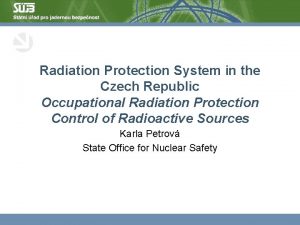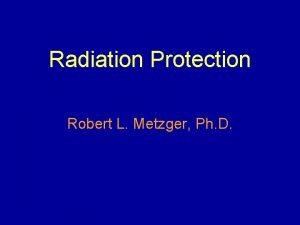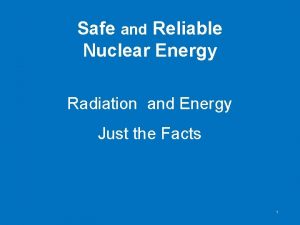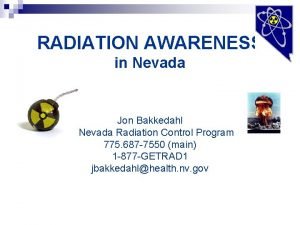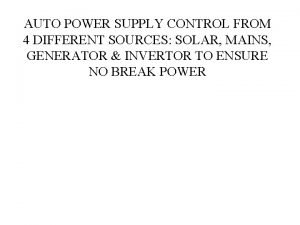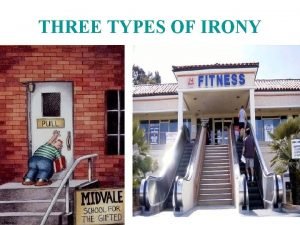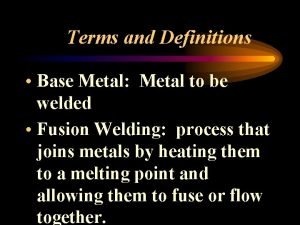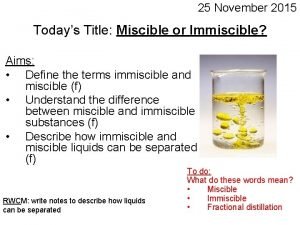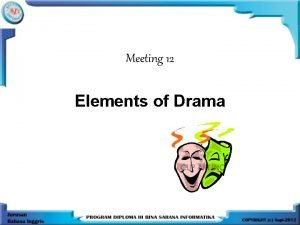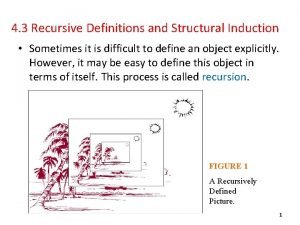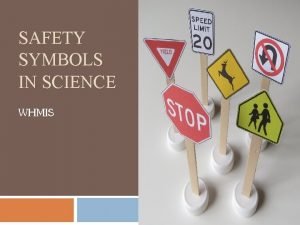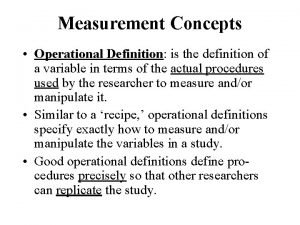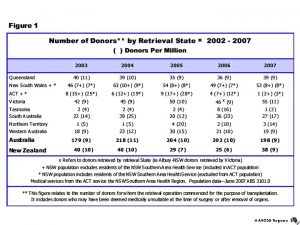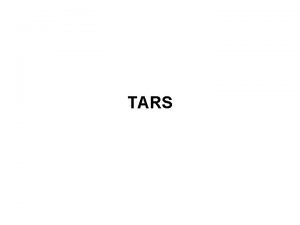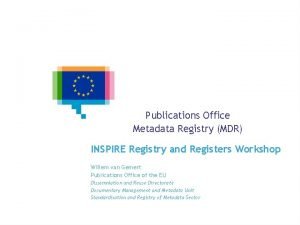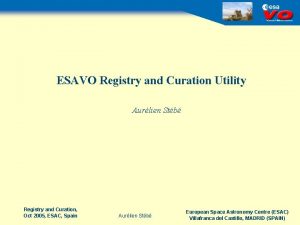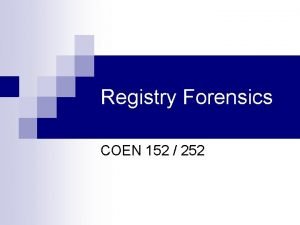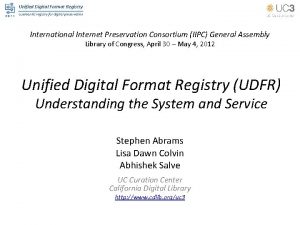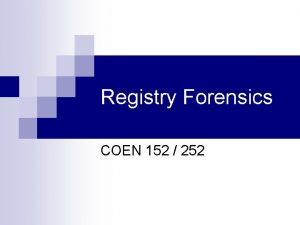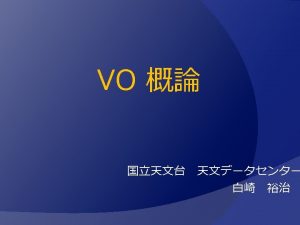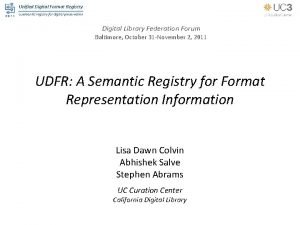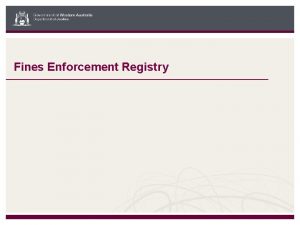Radiation Sources Registry and Control Definitions Radiation Sources














































- Slides: 46

Radiation Sources Registry and Control

Definitions Radiation Sources: • Generators (X-ray) • radioactive material • radioactive source.

Definitions • Radiation Source: Anything that may cause radiation exposure • Radiation Generators: Equipment which generated Radiation electrically • radioactive material: Material designated in national law or by a regulatory body as being subject to regulatory control because of its radioactivity. • radioactive source: Radioactive material that is permanently sealed in a capsule or closely bonded and in a solid form and which is not exempt from regulatory control.

Where radiations sources can be found? • Hospitals • • • For x-ray and radiotherapy sources X-ray private clinics Factories (steel, cement, liquids, etc. ) Pipelines companies Mine companies Research Institutes (Agriculture, veterinary, etc. ) Universities Refineries Road Construction companies School labs Industrial facilities Boats construction facilities

Radiation sources control • Radioactive material and sources are useful if proper control is applied. • Lose of proper control can lead to: Accidents or To be used for Malicious Acts

Radiological Accidents Statistics (1944 -2000) Ø~ 400 reported accidents Ø~ 3000 exposed persons Ø> 100 deaths, Øin addition, orphan sources have been mixed up with scrap causing contamination problems

Examples: causes of accidents Human error (complacency) Ø Lack of defense-in-depth Ø Ineffective safety systems (not provided or not maintained) Ø Lack of monitoring Ø Poor maintenance of devices Ø Lack of education and training Ø Lack of procedures (or not followed) Ø Lack of safety culture Ø Lack of supervision (no proper inventory check) Ø Inadequate system for sources registry (updated or completed) in the facility (accountability for sources) Ø In effective regulatory control (or not exist) (no proper inventory Ø verification) Ø No security measures

Malicious motive • Terrorism • Individual’s intent to harm other(s)

• Consequences of accidents and Malicious acts: Socio-political problems in many parts of the world

What is Sources control? • To establish system of a cradle-to-grave for the control of radiation sources, which requires: ü Establishment of National Regulatory Infrastructure for Safety to: q. Control Facilities and Activities q. Control sources involved (ex. national registry) To ensure safety of workers, patient, public and environment

Accountability of Sources The legislation shall provides for sources accountability: Registrants and licensees shall maintain an accountability system that includes records of: ØThe location and description of each source for which they are responsible ØThe activity and form of each radioactive substance for which they are responsible

Objectives of inventory of radioactive material and sources • owner is known • Ensure location of each source or material is known • Minimise the probability of sources to be vulnerable or orphan • Control of sources movements and material quantities

National register of radiation sources includes: • existing radiation sources in the country • imported radiation generators • Imported and exported radioactive sources • disused radioactive sources • collected orphan radioactive sources • radioactive waste and spent fuel

National Sources Registry is important • Number and types of sources in the country • Legal and Regulatory framework for safety needed for the country • Risk associated with each facility and activity • Number, types and level of competencies needed • Regulatory resources needed • What appropriate regulatory structure needed

National Sources Registry Provides for: knowing the owner (prime responsibility) knowing the location of each source or material (protection of public, workers and environment) Minimising the probability of sources to be vulnerable or orphan (protection of public and environment) Controlling of sources movements and material quantities • Protection of public, patient, workers and environment • Prevent Accidents • Prevent Malicious act

Radiation sources inventory • Completed, all radiation sources are included • Updated, effective mechanisms for inventory updating should established • Maintained, efficient methods shall be used (database software, …)

Inventory of source and material includes • Sufficient information to uniquely identify the source (serial • • • number or unique identification number) Radionuclide Activity of the source or material and associated date Category of the source Form of the radioactive substance (physical and chemical) The current or normal location of the source The person responsible (owner) for the source or material and contact information for that person The status and status date (in use, in storage, disused, spent, the quantity. . ) The associate equipment The purpose of the source use

Inventory of radiation generators sources includes • Sufficient information to uniquely identify the • • • source (serial number or unique identification number) Maximum energy (for generators)(KV) The current or normal location of the source The person responsible (owner) for the source and contact information for that person The status and status date The purpose of the source use

Registry of the source owner includes • • • Full information of the owner Details of the facility (address, tel, …. ) Types of facility (medical, industrial, research, …. ) License provided and it details (including renewals) Review and assessment document including the application used for licensing Inspection done and reports and results of inspections Corrective or enforcement action need to be done by the licensees and the follow-up of implementing these actions Number and types of sources in the facility or activity Accidents and incidents within the facility Workers and their qualifications (worker doses)

Responsibility of keeping the inventories • • Manufacturer and suppliers User or owners (licensees) Regulatory body Waste management organisation

Responsibilities of Manufacturers and Suppliers • Maintain a large number of records relating to their products, including: üdesign specifications ülocations where sources were shipped or where they installed sources

Responsibilities Users and Owners • Documents or records for radioactive material and sources: ü currently in their possession ü previously used ü installed in other facilities ü shipped or transferred to other users or owners ü Location and description of each source or material ü Activity and form of each radioactive substance ü Quantities ü Maximum energy for the generators ü Status of the source (in-use, dis-used)

Responsibilities of the Regulatory Body • To maintain effective system for radioactive • • material and sources inventory in the country Verify the quality of sources and material inventory system of the users Carry inventory verification Carry all types of inspections Maintaining inventory of radioactive waste and of spent fuel

Responsibilities of the waste management organisation Inventory and records of: • material and sources they received from users • treated or conditioned waste • stored waste and the locations • disposed waste

Methods for generating and maintaining of inventory • • Hard copy documentation Spreadsheet Word processing programme Database software (RAIS) üSearching üSorting üreporting

Graded approach The graded approach should be applied for radioactive material and source inventory High risk sources need more attention IAEA Training Course on Effective and Sustainable Regulatory Control of Radiation Sources

For Generators • • • Linear accelerators High voltage x-rays (more 250 KV) Fluoroscopy CT scan Panoramic X-ray for dental

Categorization of Radioactive Sources • Risk based threat assessment based on the “D” value. • Derived for emergency response. • Now used as a basis for level of protection. • Five categories.

Focus on Category 1, 2 & 3 sources Increasing Risk Category Practice Activity Ratio A/D 1 RTG’s; Irradiators; Teletherapy A/D>1000 2 Gamma radiography Brachytherapy (HDR/MDR) 1000>A/D>10 3 Fixed industrial gauges with high activity sources Well logging 10>A/D>1 4 Brachytherapy (LDR except eye 1>A/D>0. 01 plaques & perm implants) Industrial gauges that do not incorporate high activity sources; Static eliminators; Bone densitometers 5 Brachytherapy (eye pl. & perm implants); XRF; ECD 0. 01>A/D>Exempt/ D A = source activity; D = radionuclide-specific “dangerous” activity

• Adequate inventory system for category 1, 2 and 3 sources should be in place by owner or licensees and • Appropriate inventory verification system need to be applied for these categories by the regulatory body

Category 1 • Applications: • • • Radioisotopic thermoelectric generators Irradiators Teletherapy Fixed multi-beam teletherapy (gamma-knife) Seed irradiators

Examples- Teletherapy Source • • Used for treating tumors Found in medical clinics Typically contains 60 Co or 137 Cs Activity ranges from: • • 60 Co 1000– 15000 Ci (37– 560 TBq) 137 Cs 500– 1500 Ci (19– 56 TBq)

Examples- Radioisotopic Thermoelectric Generators (RTGs) • • Devices that used sources to generate heat that is converted to electricity to power various devices Typically use 90 Sr Activity ranges from: • 90 Sr 90, 000– 680, 000 Ci or (330– 25 PBq)

Examples- Grain Irradiators 137 Cs in 1000’s of Ci (37+ TBq) quantities

Examples- Blood Irradiators • • Used to sterilize blood Found in medical or research applications Typically 60 Co, 137 Cs, 170 Tm Activity ranges from: 60 Co 1500– 3000 Ci (56– 10 TBq) 137 Cs 1000– 12000 Ci (37– 440 TBq)

Category 2 • Applications: • Industrial gamma radiography • High dose rate brachytherapy and • Medium dose rate brachytherapy

Brachytherapy • Sources placed inside or near a tumor to deliver a large dose to the tumor tissue. • Radionuclide and activity depends varies based on type of tumor. . i. e. , • • • 137 Cs 60 Co 192 Ir – 198 Au – 125 I – 252 Cf

Example- Industrial Radiography Sources • • • Used to take pictures of dense objects Portable • 192 Ir , 60 Co, 75 Se, 169 Yb, 170 Tm Typical activities are 5– 200 Ci (0. 19– 7. 4 TBq)

Examples - Radiography Cameras

Category 3 • Applications: • Fixed industrial gauges • level gauges • dredger gauges • conveyor gauges containing large sources • spinning pipe gauges • Well logging gauges

Industrial Level Gauges

Category 4 • Applications: • Low dose rate brachytherapy (except 90 Sr eye • • plaques and permanent implant sources) Thickness/fill-level gauges Portable gauges (e. g. , moisture/density gauges) Bone densitometers Static eliminators

Moisture Density Gauge • • Unit has two sources: • Photon 137 Cs or 226 Ra • Neutron 241 Am. Be or 252 Cf Activities are typically • 137 Cs 8 – 11 m. Ci (300– 410 MBq) • 241 Am. Be 10– 100 m. Ci (370– 3700 MBq) • 226 Ra 2– 4 m. Ci (74– 150 MBq) • 252 Cf 0. 3– 0. 7 Ci (1. 1– 2. 6 MBq)

Category 5 • Applications: • Low dose-rate brachytherapy eye plaques and permanent implant sources • X-ray fluorescence devices • Electron capture devices • check sources

Examples- Sealed Sources

Thank you for your attention.
 Print and web sources
Print and web sources Ionizing radiation sources
Ionizing radiation sources Ionizing radiation sources
Ionizing radiation sources Nuclear energy facts
Nuclear energy facts Importance of water source
Importance of water source Radiopharmaceutical
Radiopharmaceutical Auto power supply from 4 different sources
Auto power supply from 4 different sources Auto power supply from 4 different sources
Auto power supply from 4 different sources Grits immunization login
Grits immunization login Early care and education workforce registry
Early care and education workforce registry Ca ece workforce registry
Ca ece workforce registry فروع مصر للمقاصة
فروع مصر للمقاصة Birth and death registry ghana
Birth and death registry ghana 3 kinds of irony
3 kinds of irony The problem of concept drift: definitions and related work
The problem of concept drift: definitions and related work Safety terms and definitions
Safety terms and definitions How to measure for birdsmouth cut
How to measure for birdsmouth cut Material properties definitions
Material properties definitions What does incessant mean in hatchet
What does incessant mean in hatchet Eight news values
Eight news values Compare definition
Compare definition Total cost concept in supply chain management
Total cost concept in supply chain management Undefined terms and basic definitions worksheet answers
Undefined terms and basic definitions worksheet answers Classification of sahunay
Classification of sahunay Film genres and definitions
Film genres and definitions Conceptualization, operationalization, and measurement
Conceptualization, operationalization, and measurement Biconditional statement
Biconditional statement Weld throat thickness
Weld throat thickness Match these sentences in direct and reported speech
Match these sentences in direct and reported speech A set of interrelated concepts definitions and propositions
A set of interrelated concepts definitions and propositions Restaurant terms and definitions
Restaurant terms and definitions Undefined terms and basic definitions worksheet answers
Undefined terms and basic definitions worksheet answers Pharmacopollaxy
Pharmacopollaxy Milady chapter 28
Milady chapter 28 Biconditional statement
Biconditional statement Definition of same side interior angles
Definition of same side interior angles Miscible and immiscible definitions
Miscible and immiscible definitions Unit 3 lesson 2 biconditionals and definitions
Unit 3 lesson 2 biconditionals and definitions 2-2 statements conditionals and biconditionals
2-2 statements conditionals and biconditionals Introduction match the terms with their definitions
Introduction match the terms with their definitions Material properties and definitions
Material properties and definitions Elements of drama in english literature
Elements of drama in english literature Recursive definitions and structural induction
Recursive definitions and structural induction Whmis icons
Whmis icons Operational definition psychology
Operational definition psychology What are literary elements
What are literary elements Picture of radius of a circle
Picture of radius of a circle

